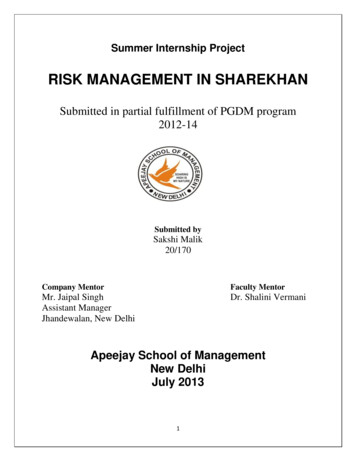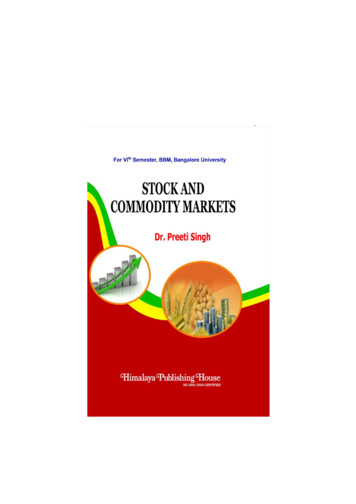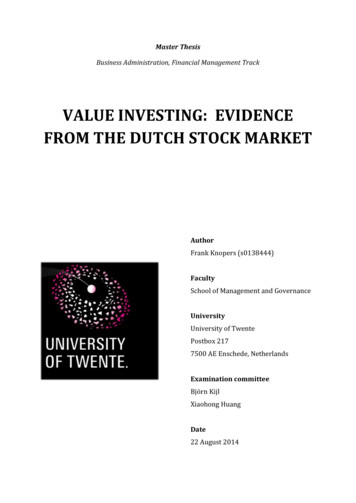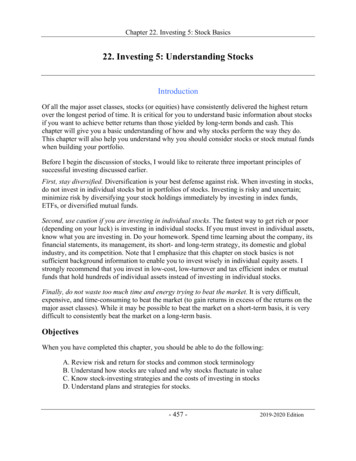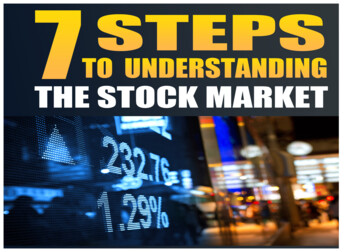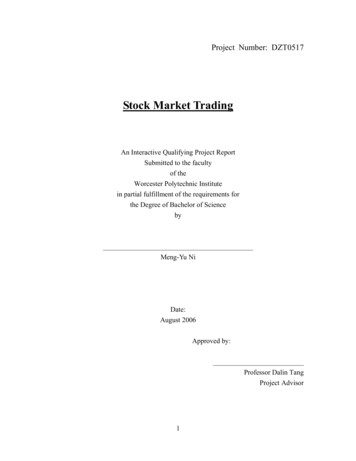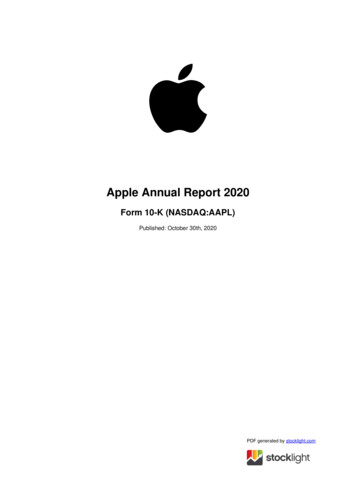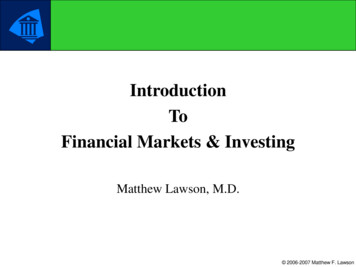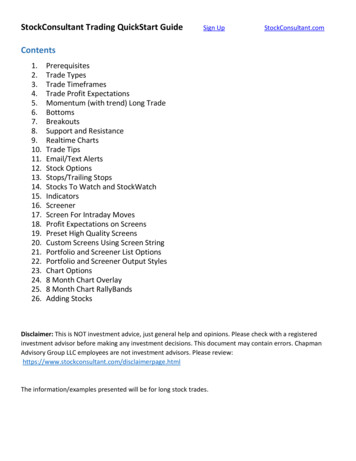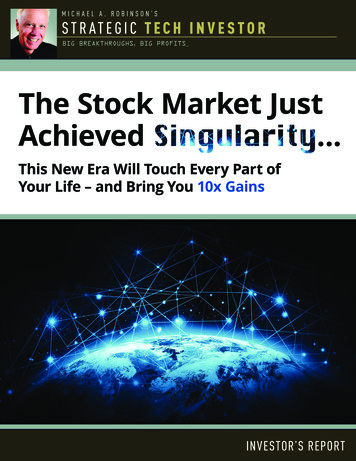
Transcription
The Stock Market JustAchieved.This New Era Will Touch Every Part ofYour Life – and Bring You 10x GainsINVESTOR’S REPORT
Dear Strategic Tech Investor ReaderThe birth of the “Singularity Era” will go down in history as a milestone in stockmarket history.However you prefer to label it – and I’ll explain my own label in just a bit – the factis that the global economy experienced a massive transformation on that day.And most investors didn’t even notice.But I’m not like most investors – or stock analysts. I’ve spent more than 30years in Silicon Valley – not on Wall Street – talking with CEOs, advising startups,hobnobbing with researchers and marketers, and researching the markets.So I noticed almost immediately why Aug. 1, 2016, was so special.When the trading day concluded that Monday afternoon, Apple Inc. (Nasdaq:AAPL), Amazon.com Inc. (Nasdaq: AMZN), Alphabet Inc. (Nasdaq: GOOGL), andMicrosoft Corp. (Nasdaq: MSFT) – all high-tech companies – were the four mostvaluable companies in the Standard & Poor’s 500 Index.That had never happened before.And it serves as tangible proof of an assertion I’ve been making for some time:In today’s global market – where competitive pressures are forcing corporations torelentlessly pursue every efficiency and advantage possible – every company is atech company.In short, the “Singularity Era” has finally arrived – bringing with it the greatestmoneymaking opportunity we’ll see in our lifetimes Data Has Become the “Coin of the Realm”Back in 1957, no pure tech firm occupied the S&P 500’s Top 10 – not even IBMCorp. (NYSE: IBM).In 1960, just three years later, IBM ranked sixth – with AT&T Inc. (NYSE: T),General Motors Co. (NYSE: GM), E.I. du Pont De Nemours and Co. (NYSE: DD),Standard Oil Co. of New Jersey (Esso), and General Electric Co. (NYSE: GE)occupying the Top Five spots.Back then – more than two generations ago – the global economy clearly ran onoil, coal, and steel.INVESTOR’S REPORT22
Now it runs on data.Digital data.In those halcyon days, manufacturing was the wealth creator. And technologywas an “augmenter” – a facilitator that would help you churn out a few more tons ofsteel or turn out a few more autos.These days, as the Aug. 1, 2016, market-cap rankings underscore, technologyenjoys a front-and-center identity all its own. Indeed, we’re now seeing a kind of“Convergence Economy” where multiple technology trends have intersected tocreate wholly new – and extremely powerful – pools of innovation.Those innovations have given tech firms like Apple and Google and Microsoftstandalone status. And the benefits of these innovations have permeated everygeographic market, every economic sector, every business, and every company onthe planet. It’s just a matter of degree.What that means, of course, is that we’ve entered a new era, an era in whichevery company on Earth has “become one” with technology – has achieved“singularity.”And that’s why we’ve anointed this as the “Singularity Era.”Why “The Singularity” Is HereRay Kurzweil, the mind behind the “singularity” concept,” has pushed theboundaries of innovation for more than five decades. As a teenager, he created agroundbreaking computer program that could play classical music and netted himan appearance on the TV game show I’ve Got a Secret.He hasn’t stopped thinking and innovating since then. Among others gadgets, heinvented omni-font optical character recognition, flat-bed scanners, text-to-speechprograms, and artificial intelligence for trading the markets.Now a director of engineering at Google, Kurzweil may be best known for hisprediction that in the near future man and machine will become intertwined in anevent he calls “The Singularity.”Kurzweil published the book The Singularity Is Near in 2005. In it, he imagineda science fiction-like world in which humans and computers fuse. As technologyaccelerates at an exponential rate, he pointed out, progress would eventuallyINVESTOR’S REPORT3
become virtually instantaneous—asingularity. Further, he predictedthat computers would merge withgenomics, nanotechnology, androbotics, making that singularitypossible.T HE KU R Z W E I L F I L EAt the time, Kurzweil’s ideasseemed outlandish. Today – despitethe advances we’ve seen in artificialintelligence and biotechnology –they still seem pretty eccentric.However, technology does seemto be accelerating faster than everbefore.And while humanity will likelynot achieve true singularity – be“uplifted” into the internet andcomputers – in any of our lifetimes,the case is different in the stockmarket.As I showed you earlier, the techsector and the markets have fused.Technology essentially is the stockmarket.For technology investors, this newSingularity Era is a good news/badnews scenario.Name: Raymond “Ray” KurzweilAlma Mater: Massachusetts Institute of TechnologyCurrent Position: Director of Engineering, Google Inc.Job: Developing machine intelligence and natural languageunderstandingInnovations: CCD flatbed scanner, omni-font optical characterrecognition, Kurzweil K250 music synthesizer, the “singularity”Books: The Age of Intelligent Machines (1990), The Age ofSpiritual Machines (1999), The Singularity Is Near (2005), Howto Create a Mind (2012)Awards: National Media of Technology and Innovation (1999),Lemelson-MIT Prize (2001)Learn More: http://www.kurzweilai.netThe fact that every company is now a “tech company” means you have whatour friends at the Pentagon might refer to as a “target-rich environment” –meaning you’ve got lots of stocks to choose from.That, of course, is also the challenge – you have lots of stocks to choose from.So while the Singularity Era represents the biggest moneymaking opportunitywe’ll see over the rest of our lifetime, cashing in requires you to pick the righttech opportunities.Or what we refer to as “Singularity Plays.”INVESTOR’S REPORT4
One reason that we’ve achieved “singularity” – with the tech giants dominatingthe markets and every company becoming a tech company – is the reality thattechnology’s contribution to economic growth continues to surge.And that means its influence on wealth creation will continue to surge, as well.The following five “data points” help explain how technology already hastransformed our world – and how technology will continue to fuse with themarkets.1.Smartphones are everywhere. The number of smartphones in the worldtopped 2 billion in 2016. If you add in tablet computers and other connecteddevices, that figure reaches 7 billion. That’s more than one connected devicefor every person on the planet. And the number of users is expected to reach2.66 billion by 2019. And to think that 30 years ago there were exactly zeromobile phones around. We went from a market worth nothing to a marketworth 327 billion by 2016. And now even mobile sub-markets are soaring.In 2016, the global mobile app market reached 51 billion. By 2020, thatnumber will exceed 101 billion.2.Technology has hollowed out the demand for low-skilled workers. A2013 study from Oxford University predicts that up to 47% of U.S. jobs willbe computerized in the next two decades. Even white-collar professionals,like lawyers, doctors, and financial advisors, are under threat fromtechnology. However, this opens up an opportunity for tech investors, astech subsectors like robotics and artificial intelligence soar. The analysts atTractica forecast that the global artificial intelligence market will grow from 643.7 million in 2016 to 36.8 billion by 2025. That’s a 57-fold increase. Theglobal IT robotic automation market alone, valued at 183.1 million in 2013,is expected to experience a compound annual growth rate (CAGR) of 60.5%from 2014 to 2020.3.Biotechnology is solving previously insurmountable problems. Overthe past few years, biotech researchers have made everything fromimmunotherapy (treatments that boost our own immune systems to fightdisease) to liquid biopsies (noninvasive tests of blood or urine to detectdisease) possible. According to recent data, venture capital firms heaped 11billion into healthcare companies in 2014. That’s a 30% jump over 2013. Theglobal biotechnology market, valued at 270.5 billion in 2013, is expected togrow at a CAGR of 12.3% between then and 2020.4.More people than ever are learning online. At last count, morethan 80,000 education apps were available for download through Apple’sINVESTOR’S REPORT5
App Store, with 72% of those aimed at toddlers and preschoolers. Moreover,the massive open online course (MOOC) market size is forecast to growfrom 1.83 billion in 2015 to 8.5 billion by 2020, at a CAGR of 36%. MOOCsare free or inexpensive college-level courses delivered over the web to tensof thousands of students all over the globe.5.Cybercrime now costs the world 445 billion annually. That’s accordingto a recent study from the Center for Strategic and International Studies(CSIS), a think tank stocked with former U.S. intelligence officials. And thatcost is growing at a frantic rate: According to the CSIS report, annual lossescould soar to 575 billion in very short order. But like with the automationcaused job crisis, these cybersecurity worries bring with them opportunities.The cybersecurity market is forecast to grow from 122.45 billion in 2016 to 202.36 billion by 2021.Of course, those are just small slices of the technology sector and its growth ascompared to the global market. To examine that, let’s take a look at the Internet ofEverything.This 24 Trillion Market Is Taking OverThe IoE is the glue that binds the “Convergence Economy” together.It’s a new high-tech reality where almost everything is “connected” and able tocommunicate.Think of a kind of “Super Internet” that opens the door to all sorts ofopportunities, including “Wearable” technology like smart watches, fitness trackers, and intelligentglasses. Special monitoring devices that could signal when an airline pilot or a longhaul trucker starts showing signs of fatigue. “Smart homes” that can be configured from afar (you could control yourentertainment system, your air conditioner, or safety-monitoring systems). Components in “connected” cars, trucks, and airplanes that can signal whenthey’re about to fail. Sensors that can help vehicles – even those that are “unpiloted” – avoidcollisions.INVESTOR’S REPORT6
And medical devices you can swallow that then perform diagnostic tests, ortreat your cancer, heart disease, diabetes or any other illness you can think of.Ericsson, one of the largest telecoms on the planet, says that by 2020 more than50 billion enabled devices will be talking to each other.And that’s just the beginning.As of 2013, barely 0.6% of devices that could be connected were connected.And still today, more than 90% of things that could be included in the Internet ofEverything have yet to be.As it stands now, the technology spans into nearly every economic, social, andcivil segment of society. As we speak, everyone who’s anyone in the tech sector iscurrently investing millions – even billions – to claim their stake in this once-in-amillennium tech movement, hoping to position themselves as a market leader:IBM is spending close to 2 billion a year to secure itsmarket share Hewlett PackardEnterprise Co. (NYSE: HPE) ismaking a 10 billion investmentto establish its dominance in theIoE and Cisco Systems Inc.(Nasdaq: CSCO) has announcedplans to restructure itself aroundit.The fact is, the IoE is rapidlyturning Earth into a “smart” planetwhere everything – man, machineeven nature – is interconnected.That’s another “singularity.”A PPR O A C H I N GS I N G UL A R I TYThe growth of technology is far outpacing that of gross worldproduct (GWP). For example, the global Internet ofEverything (IoE) market currently makes up 2.7% of theglobal economy. By 2020, according to forecasters, it couldmake up 26.2% of GWP. That’s the “Singularity Era” in action.IoE2015GWPIoE2020GWP 2.00T 73.99T 23.97T 91.37TSources: Statista, ResearchandMarkets, Strategic Tech Investor staff researchIt’s an economic singularity, too.The analysts at ResearchandMarkets expect the IoE market to grow from about 2 trillion now to 23.97 trillion by 2020.To put that in perspective, the gross world product (GWP) stood at 73.99trillion in 2015. And global economists expect that number to grow to 91.37trillion in 2020.INVESTOR’S REPORT7
That means just the Internet of Everything is advancing from 2.7% of the globaleconomy to 26.2% of GWP.That alone makes technology’s capture of the markets a true singularity.And Singularity Plays are the single best way to capitalize on the IoE and theother trends I’ve been showing you. They’ll be the only way to outpace inflation,to build wealth, and to achieve outside market returns in the years, decades, andgenerations to come.Plus, they’ll provide a kind of “downside protection” – because the advances intechnology that are fostering the efficiencies we’ve referred to are also going tohelp companies eliminate jobs at an accelerating rate.What will make this a bit easier is the fact that our research has found that thereare really four Singularity Era “windows” of opportunity. These windows representpools of innovation that will lead to new intersections in the “ConvergenceEconomy” we’ve been talking here.Introducing the Singularity NexusNearly every profit opportunity I’ll bring to you in the coming weeks and monthsfits into at least one of these windows – which make up the “Singularity Nexus.”These four windows cover nearly every facet of our lives How We Live: From personal computers and smartphones toconnected cars and streaming media, technology has upendedthe way we live. But those trends are really still in their infancy.Soon, small towns and big cities alike will be brimming withsensors, smart meters, connected cameras, and, most importantly, fiberoptic cables that monitor temperature, energy consumption, traffic, bus andsubway arrivals and departures, and even crime. All this smart technologymakes cities run more smoothly. It also makes them safer and more energyefficient. The researchers at Frost & Sullivan predict 26 high-level smartcities worldwide by 2025. Further, MarketsandMarkets says the smartcity market will nearly double by 2019, to 1.27 trillion. The smart homesthat make up these cities are also advancing quickly ( 121.73 billion marketby 2022). The How We Live window also includes education tech (a 252billion market by 2020); personal financial tech; and various ways weentertain ourselves, such as video games ( 100 billion market right now) andvirtual reality ( 162 billion by 2020).INVESTOR’S REPORT8
How We Work: As artificial intelligence ( 36 billion by 2025)and other forms of automation take over more and more ofthe workforce, it becomes more and more necessary to investin tech as a form of insurance against the jobless future.Augmented reality, or smart glasses ( 90 billion by 2020); the bring yourown device (BYOD) trend ( 367 billion by 2022); and IT services ( 3.8trillion by 2020) also fit in here. Then there’s cloud computing, in whichcorporations’ data and software live on the internet (via huge “serverfarms), not on computer hard drives. Some forecasts say cloud computingis growing form 41 billion in 2011 to 270 billion in 2020. That’s 559%growth in less than 10 years.How We Survive: There are security issues in East Asia, thanksto North Korea’s nuclear ambitions and China’s belligerence,as well as in the Middle East, due to ISIS and other terroristgroups. Plus, hackers and cyber thieves are causing chaos righthere at home and stealing billions of dollars a year. Uncertainty is thewatchword, and any of these “pools of worry” could touch off a correctionin stock prices. But with every threat comes an opportunity. I’m talkingabout defense (global military spending was nearly 1.7 trillion in 2015and could reach 2.4 trillion by 2024) and cybersecurity ( 202.36 billion by2021). And because we focus on technology here, I’m specifically thinkingof futuristic advanced weapons and systems. Investments of this type arelikely to enjoy broad support on Capitol Hill and in the White House,meaning we’ll see spending increases in all these areas.How We Thrive: I’ve followed biotech for almost 25 years andI’ve never seen so many advances coming so quickly. I predictthat the biotech innovations that are being researched nowwill help us cure cancer, end the scourge of Alzheimer’s, andmake 100-year human life spans the rule, rather than the exception.And now that it has a complete map of the human genome in its tool kit,biotech has truly reached critical mass. For example, the sector is givingus breakthrough drugs called biologics. These are compounds made fromthe cells of mammals. Biologic drugs are now being used to target cancercells with pinpoint accuracy. The biologic market has already passed the 200 billion mark and is expected to reach 500 billion by 2019. Thenthere’s, synthetic biology ( 13.4 billion by 2019), which is using lab-createdbiological systems to produce pollution-ending chemicals, create biofuels,and make proteins for vaccines. And antiaging treatments combined withsuch RNAi therapies could bring in as much as 595.56 billion by 2020.And that’s not even getting into the food manufacturers and agriculturalINVESTOR’S REPORT9
companies that are improving our diet through such advances as organicfood ( 211.44 billion by 2018) and precision farming ( 8.8 billion by 2025).The subsectors and dollar amounts I’ve described in these categories barelyscratch the surface of the growth we’ll see due to the Singularity Era.After all, tying it all together is the Internet of Everything.As I showed you earlier, IoE spending alone could make up more than 25% ofGWP by 2020. As we advance toward a global economy of 90 trillion and beyond,the tech sector will grab more and more of that.And that’s why you need I guide like myself – to separate the Singularity Playsthat will win in the future and those that will be left behind.What’s Next Here’s what I’m going to do in the coming weeks andmonths.We’ll explore each category in the Singularity Nexus –going in-depth into what they are and the markets within theMoreover, after analyzing and investing in technologystocks for more than 30 years, I have perfected a TechWealth Blueprint.These five “rules” can help you become a much savvier andfar more profitable tech investor. I crafted them to help youidentify the biggest market trends – and the Singularity Plays best positioned toyield hefty profits.Even more importantly, with them, you’ll avoid the most common tech pitfalls –like chasing a sexy-sounding but ultimately worthless initial public offering (IPO) or buying into a poorly performing small-cap in the hopes it will be acquired by ahigh-spending tech giant.In the coming weeks, I’ll show you how to use that Tech Wealth Blueprint andall the other wealth-building (and -keeping) strategies and tactics I’ve developedover the years. With them, you’ll soon find yourself tapping into the industry’s mostexciting and fastest moving opportunities capturing extreme wealth and living abetter life now and in retirement.INVESTOR’S REPORT10
Finally, I’ll bring you the Singularity Plays – the stocks, funds, and otherinvestments with the best chance of making 10 gains or beyond.Like I’ve been saying, in the Singularity Era, you have to know how to find theright company at the right time.Here’s just a couple of examples of what I’m talking about I recommended Ambarella Inc. (Nasdaq: AMBA) to my readers on Aug. 2, 2013.Since then, this developer of video chips has gone on a rocket ride. Less than twoyears after that, they had peak gains of 691%.Then there’s U.S. Silica Holdings Inc. (NYSE: SLCA). I suggested this MiracleMaterials small-cap firm back on Feb. 7, 2014. Less than seven months later peakgains of 260%.And I got my readers in on Tesla Motors Inc. (Nasdaq: TSLA) way before WallStreet had caught on to what Elon Musk is doing. They’ve made peak gains of115.6%.Since those are the kinds ofreturns than can supercharge justabout any investors’ portfolio,let’s do the math.Take the average American’snet savings of 25,000 and boostit by 691%.Not counting taxes, you windup with a new net worth of 172,750. Do that a few times andyou’re on Easy Street.A PRELUDE TO YOUR 10X GAINSSince I started this service several years ago, my readers havemade dozens of double-digit gains and much more than a fewtriple-digit gains of 116% from Tesla Motors 260% fromU.S. Silica and 691% from Ambarella. But that’s nothingcompared to the 10x gains we’ll see in the Singularity Era.TeslaU.S. Silica300116%Ambarella200691%100I just pulled these examples offthe top of my head. I’ve delivereddozens of double-digit winners –and much more than a few tripledigit winners – to my readers.260%0201420152016Sources: Strategic Tech Investor Staff ResearchAnd that will be nothing compared to what’s coming due to the Singularity Era.With the kind of tailwinds this new era is creating, we’ll be seeing gains of 2 5 10 – and more.INVESTOR’S REPORT11
The dawning of the Singularity Era was the moment when the technologyeconomy converged with the entire stock market.We’re at that “zero hour” right now.This new era will create more millionaires than ever before.You can be one of them – if you know where and when to pounce.The painstakingly researched Singularity Plays I’ll be sending your way each andevery week – along with the strategies and tactics I’ll also be sharing with you – willget you to that point.It’s “How You Will Thrive.”Now and in the future.Cheers and good investing,Michael A. RobinsonINVESTOR’S REPORT12
Please Note: From time to time, Money Map Press will recommend stocks or other investments that will not be included in our regular portfolios.There are certain situations where we feel a company may be an extraordinary value but may not necessarily fit within the selection guidelines ofthese existing portfolios. In these cases, the recommendations are speculative and should not be considered as part of Money Map Press philosophy.Also, by the time you receive this report, there is a chance that we may have exited a recommendation previously included in our portfolio.Occasionally, this happens because we use a disciplined selling strategy with our investments, meaning that if a company’s share price fallsbelow a certain price level, we immediately notify our subscribers to sell the stock.NOTE: Money Map Press is not a broker, dealer or licensed investment advisor. No person listed here should be considered as permitted toengage in rendering personalized investment, legal or other professional advice as an agent of Money Map Press. Money Map Press does notreceive any compensation for these services. Additionally, any individual services rendered to subscribers by those mentioned are consideredcompletely separate from and outside the scope of services offered by Money Map Press. Therefore if you choose to contact anyone listed here,such contact, as well as any resulting relationship, is strictly between you and them.Copyright 2007-present, Money Map Press, 16 W. Madison Street, Baltimore, MD 21201Phone: 888.384.8339 or 410.226.4519All rights reserved. Money Map Press provides its members with unique opportunities to build and protect wealth, globally, under all market conditions.The executive staff, research department and editors who contribute to Money Map Press recommendations are proud of our history and reputation. Webelieve the advice presented to our subscribers in our published resources and at our meetings and seminars is the best and most useful available toglobal investors today. The recommendations and analysis presented to members is for the exclusive use of members. Copying or disseminating any information published by Money Map Press, electronic or otherwise, is strictly prohibited. Members should be aware that investment markets have inherentrisks and there can be no guarantee of future profits. Likewise, past performance does not assure future results. Recommendations are subject to changeat any time, so members are encouraged to make regular use of the website and pay special attention to Money Map Press updates sent out via e-mail.The publishers, editors, employees or agents are not responsible for errors and/or omissions.Privacy NoticeYou and your family are entitled to review and act on any recommendations made in this document. All Money Map Press publications are protected bycopyright. No part of this report may be reproduced by any means (including facsimile) or placed on any electronic medium without written permissionfrom the publisher. Information contained herein is obtained from sources believed to be reliable, but its accuracy cannot be guaranteed. Money MapPress expressly forbids its writers from having a financial interest in any security recommended to its readers. All Money Map Press employees andagents must wait 24 hours after an Internet publication and 72 hours after a print publication is mailed prior to following an initial recommendation.Money Map Press does not act as a personal investment advisor, nor does it advocate the purchase or sale of any security or investment for any specificindividual. Investments recommended in this publication should be made only after consulting with your investment advisor, and only after reviewing theprospectus or financial statements of the company.STI0217-778Money Map Press 16 W. Madison Street Baltimore, MD 21201 888.384.8339 or 410.353.4519WEB
prediction that in the near future man and machine will become intertwined in an event he calls “The Singularity.” Kurzweil published the book The Singularity Is Near in 2005. In it, he imagined a science fiction-lik
